
Bolesław III Wrymouth, also known as Boleslaus the Wry-mouthed, was the duke of Lesser Poland, Silesia and Sandomierz between 1102 and 1107 and over the whole of Poland between 1107 and 1138. He was the only child of Duke Władysław I Herman and his first wife, Judith of Bohemia.

The Duchy of Greater Poland was a district principality in Greater Poland that was a fiefdom of the Kingdom of Poland. It was formed in 1138 from the territories of the Kingdom of Poland, following its fragmentation started by the testament of Bolesław III Wrymouth. In 1177, the state broke had separated into the duchies of Poznań, Gniezno and Kalisz, and united again in 1279, lasting in that form until 1320, when it was incorporated back into the Kingdom of Poland. Its capital was Poznań.

Bolesław IV the Curly, a member of the Piast dynasty, was Duke of Masovia from 1138 and High Duke of Poland from 1146 until his death in 1173.

Przemysł I, a member of the Piast dynasty, was Duke of Greater Poland from 1239 until his death, from 1241 with his brother Bolesław the Pious as co-ruler. He was able to re-acquire large parts of Greater Poland, ruling as Duke of Poznań and Gniezno from 1247 and, upon several inheritance conflicts with his brother, as Duke of Poznań and Kalisz from 1249, sole Duke of Greater Poland from 1250, and Duke of Poznań from 1253 until his death.
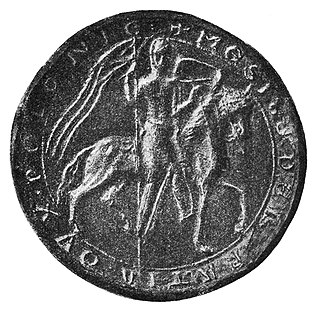
Mieszko III, sometimes called the Old, was Duke of Greater Poland from 1138 and High Duke of Poland, with interruptions, from 1173 until his death.
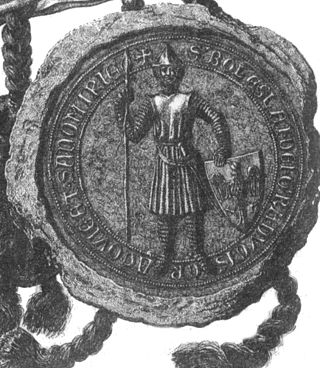
Bolesław V the Chaste was Duke of Sandomierz in Lesser Poland from 1232 and High Duke of Poland from 1243 until his death, as the last male representative of the Lesser Polish branch of Piasts.
Władysław III Spindleshanks, of the Piast dynasty, was Duke of Greater Poland, High Duke of Poland and Duke of Kraków during 1202–1206 and 1228–1231, Duke of Kalisz during 1202–1206, ruler of Lubusz during 1206–1210 and 1218–1225, and ruler over Gniezno during 1216–1217.

Zbigniew, was a duke of Poland during 1102–1107. He was the first-born son of Władysław I Herman and Przecława, possibly a member of the Prawdzic family.
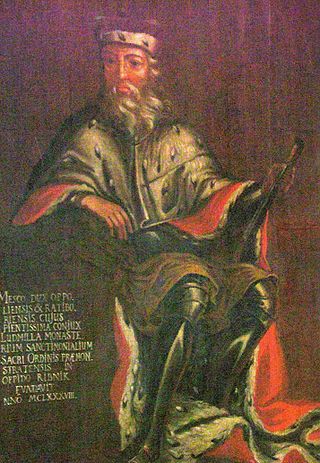
Mieszko IV Tanglefoot was Duke of Kraków and High Duke of Poland from 9 June 1210 until his death one year later. He was also Duke of Silesia from 1163 to 1173, Duke of Racibórz from 1173, and Duke of Opole from 1202.

Henry the Bearded was a Polish duke from the Piast dynasty.

The Duchies of Silesia were the more than twenty divisions of the region of Silesia formed between the 12th and 14th centuries by the breakup of the Duchy of Silesia, then part of the Kingdom of Poland. In 1335, the duchies were ceded to the Kingdom of Bohemia under the Treaty of Trentschin. Thereafter until 1742, Silesia was one of the Bohemian crown lands and lay within the Holy Roman Empire. Most of Silesia was annexed by the King of Prussia under the Treaty of Berlin in 1742. Only the Duchy of Teschen, the Duchy of Troppau and the Duchy of Nysa remained under the control of the Bohemian crown and as such were known as the Duchy of Upper and Lower Silesia until 1918.
Henry I of Sandomierz was the duke of Sandomierz from 1138 until his death. He took part in the Second Crusade. Upon his return from the Holy Land, Henry organized a battle against the Prussians and died in battle.
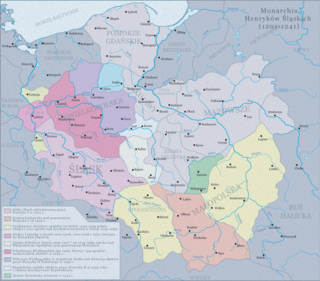
Seniorate Province, also known as the Senioral Province, was a district principality in the Duchy of Poland that was formed in 1138, following the fragmentation of the state. Its ruler held the title of the High Duke, ruling all duchies within Poland. In 1227, following the abolition of the High Duke title, the province was transformed into the Duchy of Kraków.

Mieszko II the Fat was a Duke of Opole-Racibórz from 1230 until his death, and Duke of Kalisz-Wieluń during 1234–1239.
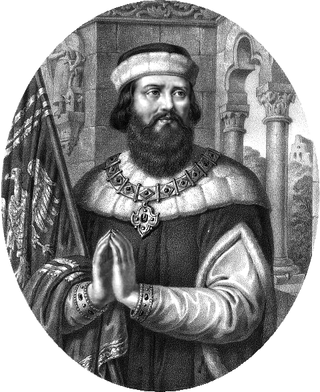
Casimir II the Just was a Lesser Polish Duke of Wiślica from 1166 to 1173, and of Sandomierz after 1173. He became ruler over the Polish Seniorate Province at Kraków and thereby High Duke of Poland in 1177; a position he held until his death, though interrupted once by his elder brother and predecessor Mieszko III. In 1186 Casimir also inherited the Duchy of Masovia from his nephew Leszek, becoming the progenitor of the Masovian branch of the royal Piast dynasty, and great-grandfather of the later Polish king Władysław I the Elbow-high. The honorific title "the Just" was not contemporary and first appeared in the 16th century.
Agnes of Poland was a member of the House of Piast and by marriage princess of Pereyaslavl and Volynia and grand princess of Kiev since 1168.
Roman Grodecki, Poraj coat of arms, was a Polish economic historian, a professor at the Jagiellonian University in Kraków, and a member of the Polish Academy of Arts and Sciences.

The Duchy of Sandomierz was a district principality and a fiefdom of the Kingdom of Poland. It was formed in 1138 from the territories of the Kingdom of Poland, following its fragmentation, that was started by the testament of Bolesław III Wrymouth. The Duchy existed until 1320 when it was incorporated into the Kingdom of Poland. Its capital was the city of Sandomierz. The territory was centred around Sandomierz Land in the southeastern corner of Poland, between the rivers of Pilica, Vistula, San, and Dunajec.
This is the 1028-1031 German-Polish War. For a list of all Polish-German Wars, see Polish-German Wars.
Mikołaj Gryfita was a Voivode of Kraków from 1176 to 1202, and acted as a regent from 1198 to 1199 on behalf of Prince Leszek the White.












